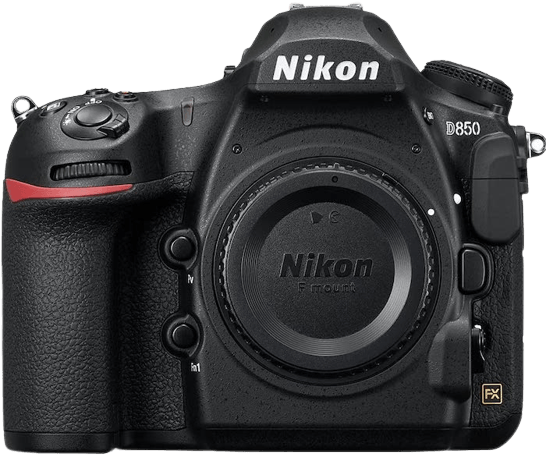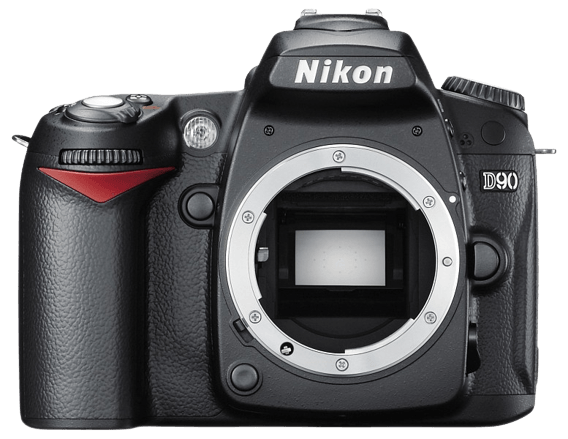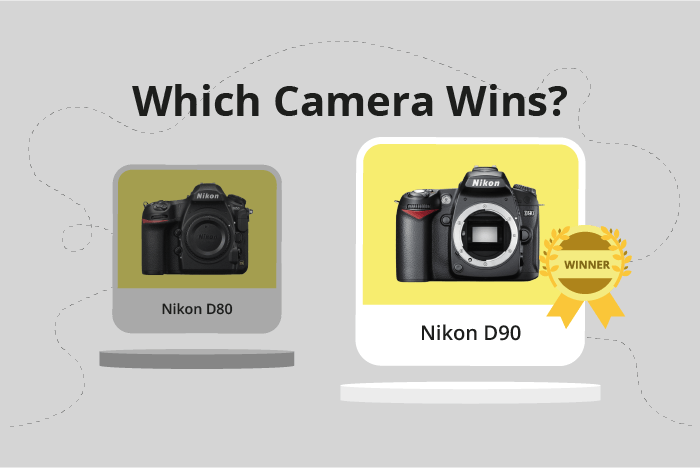Nikon D80 vs D90 Comparison
Nikon D80

Nikon D90

The Nikon D90 emerges as the winner with a score of 44/100, while the Nikon D80 trails behind at 34/100. Both cameras share similarities as DSLR cameras released by Nikon, with identical dimensions of 132 x 103 x 77mm. The D90, released in 2008, has a higher launch price of $1235 compared to the D80’s $730 in 2006.
The D90’s higher score reflects its superior performance and features. However, the D80 does hold an advantage in weight, being lighter at 668g compared to the D90’s 703g. This could make the D80 more appealing for those prioritizing portability.
Taking all factors into account, the Nikon D90 stands out as the better camera, offering enhanced performance and capabilities. Yet, the Nikon D80 remains a viable option for those seeking a more budget-friendly and lightweight DSLR.
Nikon D80 vs D90 Overview and Optics
The Nikon D90 outperforms the Nikon D80 in optics with a score of 46/100 as opposed to the D80’s 39/100. This 7-point difference highlights the superiority of the D90 in this area.
Both cameras share some common specifications, such as the APS-C sensor size, Nikon F DX lens mount, and the absence of image stabilization. Despite these similarities, the D90 has a higher resolution with 12.3 megapixels compared to the D80’s 10 megapixels. This results in better image quality and more detailed photographs.
The Nikon D90 also has a faster shooting speed of 4.5 frames per second, compared to the D80’s 3 frames per second. This advantage allows photographers to capture fast-moving subjects more effectively. Moreover, the D90 features a CMOS sensor and an Expeed processor, which contribute to its higher DXOMARK score of 73, while the D80 has a CCD sensor and a Nikon Image processing engine, resulting in a lower DXOMARK score of 61.
On the other hand, the Nikon D80 has its merits, such as being more affordable and lightweight compared to the D90. However, these benefits do not outweigh the advantages of the D90 in terms of optics.
Taking all these factors into account, the Nikon D90 clearly surpasses the Nikon D80 in optical performance. Its higher resolution, faster shooting speed, and better sensor technology make it a superior choice for photographers who prioritize image quality and capturing fast-moving subjects. While the D80 may be more accessible in terms of price and weight, the D90’s enhanced optics make it worth the investment.
Nikon D80 vs D90 Video Performance
When examining the video capabilities of the Nikon D80 and Nikon D90, it is important to note that neither camera offers video functionality. As a result, there is no difference in video performance between these two cameras.
Nikon D80 vs D90 Features and Benefits
The Nikon D90 emerges as the winner, with a feature score of 41/100, while the Nikon D80 scores 17/100. Both cameras share certain specifications ��� neither has a touchscreen, flip screen, or GPS. However, the differences in other features lead to the D90’s superiority.
The D90 has a larger screen size of 3 inches, compared to the D80’s 2.5 inches. This allows for better image preview and camera setting adjustments. Furthermore, the D90’s screen resolution is significantly higher at 920,000 dots, compared to the D80’s 230,000 dots. This results in a sharper and clearer display, enhancing the user’s experience.
The D80 does have one advantage over the D90, which is the presence of WIFI. This feature allows for easy image transfer and remote camera control through a smartphone or tablet. However, this advantage is not enough to outweigh the benefits of the D90’s superior screen size and resolution.
In conclusion, the Nikon D90’s larger screen size and higher resolution make it a better camera in terms of features compared to the Nikon D80. While the D80 does offer WIFI connectivity, this is not sufficient to overcome the D90’s advantages. Therefore, the Nikon D90 is the better choice for photographers seeking a camera with superior features.
Nikon D80 vs D90 Storage and Battery
The Nikon D80 emerges as the winner in the storage and battery category with a score of 53, while the D90 trails behind at 37. Both cameras share similarities in storage capabilities, with one memory card slot each and compatibility with SD and SDHC cards. Additionally, neither camera offers USB charging, utilizing the same battery type, EN-EL3e.
The D80 outperforms the D90 in battery life, providing 2700 shots per charge, significantly more than the D90’s 850 shots. This advantage makes the D80 more suitable for extended photography sessions and reduces the need for frequent battery replacements or recharging.
On the other hand, the D90 does not have any specific advantages over the D80 in the storage and battery department. The lower score simply reflects its shorter battery life compared to the D80.
Taking these factors into account, the Nikon D80 proves to be the superior choice for photographers prioritizing storage and battery performance. Its longer battery life ensures more shooting opportunities, while both cameras maintain similar storage capabilities.
Nikon D80 vs D90 – Our Verdict
Are you still undecided about which camera is right for you? Have a look at these popular comparisons that feature the Nikon D80 or the Nikon D90:

